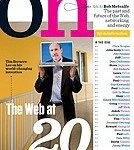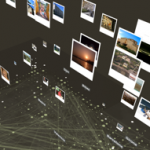Jan28
Preparing for the Unknown
Point: You may not be able to predict the future, but you can prepare for it by tracking early trends and staying open to disruptions.
Story: What will the web look like in 20 years? Stuart Miniman of the Office of the CTO at EMC Corporation asked me to contribute my thoughts on this, as part of EMC’s ON magazine celebration of the web’s 20th anniversary.
My predictions for 2030? I know that I don’t know, but I do follow some heuristics that are helpful regardless of which future materializes.
“You can’t predict the future,” said Google’s Eric Schmidt back in 1993 when he was president of Sun Technology Enterprises (a subsidiary of Sun Microsystems). “But you can estimate it. Your estimations are based on understanding the model of technology.” Schmidt’s mental model of technology involves looking at underlying drivers and expecting innovation from anywhere. “Don’t think your company is the best and will be the first to come with an innovation in your area. That attitude will lead you to become blindsided.”
With that in mind, here are two trends I’ll be watching closely for emerging innovations:
* Geo-Spatial Data and Semantic Smarts
Consider these facts by Jeff Jonas, IBM Distinguished Engineer and Chief Scientist, Entity Analytic Solutions, IBM Software Group:
Mobile devices in America are generating something like 600 billion geo-spatially tagged transactions per day. Every call, text message, email and data transfer handled by your mobile device creates a transaction with your space-time coordinate, whether you have GPS or not. Every few minutes, it sends a heartbeat, creating a transaction whether you are using the phone or not.
The implications? Companies can use data analytics to learn unprecedented amounts of information on their customers (how far they travel, locations where they hang out, the people they hang out with). It may sound like big brother, but some consumers are already turning this into a big game and social lifestyle with the help of companies like Foursquare, Loopt, Brightkite, etc. There’ll be opportunities for companies to use this data combined with web-based data to serve their customers better.
With every device and service gathering more and more data and becoming more connected, systems will begin to “understand” the meaning of the data to give people what they want. I don’t know if real AI will ever happen, but with all the available data, social tools, and clever people building clever companies, it seems that devices are going to act like they know the meaning behind the data and and take or suggestion actions to help you. For example, if your cellphone knows your calendar’s next appointment, your location, and gets the Tweets about the traffic jam on the highway, it can alert you to leave a little earlier or alert whomever you’re meeting that you’ll be late.
* Social/Distributed Decision-Making
Knowledge-intensive tasks such new product and service development will be aided by enterprise-wide collaboration systems with built-in voting, reputation systems, and predictive markets. These concepts were envisioned by MIT Prof. Thomas W. Malone before the Web as we know it even existed. His publications, such as Computers, Networks and the Corporation, describe the organizational changes that networked computers would bring.
Tom Malone now heads the Center for Collective Intelligence at MIT. The center’s basic research question is: How can people and computers be connected so that—collectively—they act more intelligently than any individuals, groups, or computers have ever done before?
I think one of the most powerful uses of the web in the future is for crowdsourcing and open innovation to tackle some of the world’s biggest problems. Take, for example, that Innocentive just announced a GlobalGiveback Innovation Challenge Set to help solve some of the world’s water problems through open innovation. Other crowdsourcing platforms like ideas4all.com are enabling entrepreneurs to suggest product, service and business ideas to win funding. The web will enable collaboration on a global scale that will let us marshal our creative energies to tackle global issues.
What do you think?
And, yes, whatever the future brings, there’ll be an app for that.
Action
- Look for things that are becoming ubiquitous but aren’t being used as much as they could be.
- Avoid self-centered attitudes about the future. Just because you don’t want to be tracked doesn’t mean others don’t want to be tracked or that someone won’t create a fun and rewarding reason to change your mind about tracking.
- Look for chocolate+peanut-butter combinations like geo-spatial data + semantics.
- Test out some crowdsourcing platforms (ideas4all.com is public and ongoing) to get a feel for how they work. Consider how you could apply them.
Sources:
EMC’s ON magazine: The Web at Twenty
Jeff Jonas: Your Movements Speak for Themselves
Eric Schmidt at the University of Colorado-Boulder, February 9, 1993












